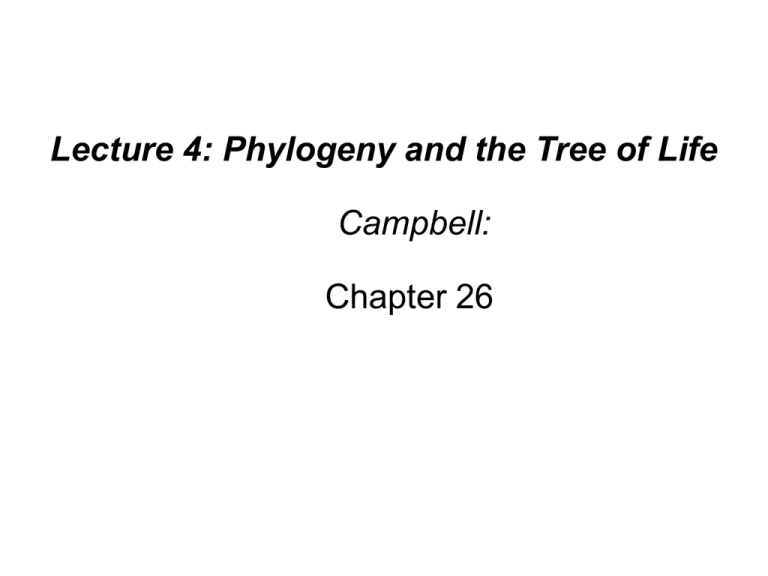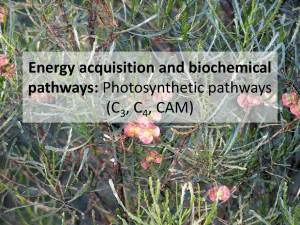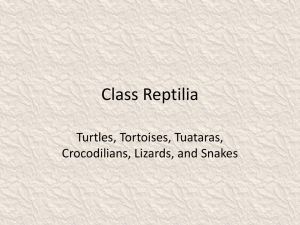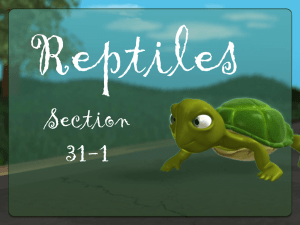PowerPoint Presentation - BIOLOGY 201: PRINCIPLES OF
advertisement

Lecture 4: Phylogeny and the Tree of Life Campbell: Chapter 26 All life is interconnected by descent Bacterium Amoeba Pine tree Rattlesnake Humans How to determine the pattern of descent? Systematics - field of biology dealing with diversity and evolutionary history of life Includes Taxonomy: DINC Description Identification Nomenclature Classification Goal: – Determine Evolutionary History (Phylogeny) of Life Description = assign features Character = a feature (e.g., “petal color”) Character states = two or more forms of a character (e.g., “red,” “white”). Identification = associate an unknown with a known How? One way: Taxonomic Key, e.g., Tree Leaves simple …….………………………… Species A Leaves pinnate …….………..…..…..…… Species B Herb Flowers red …….…………………………… Species C Flowers white …….…………………..…… Species D Nomenclature Naming, according to a formal system. Binomial: Species are two names (Linnaeus): E.g., Homo sapiens Homo = genus name sapiens = specific epithet Homo sapiens = species name Nomenclature Hierarchical Ranks: Domain Kingdom Phylum Class Order Family Genus Species Classification • Placing objects, e.g., life, into some type of order. • Taxon = a taxonomic group (plural = taxa). How to classify life • Phenetic classification – Based on overall similarity – Those organisms most similar are classified more “closely” together. Problem with phenetic classification: • Can be arbitrary, e.g., classify these: Phylogenetic classification • Based on known (inferred) evolutionary history. • Advantage: – Classification reflects pattern of evolution – Classification not ambiguous lineage or clade TIME Cladogram or Phylogenetic Tree = representation of the history of life TAXA A B C D E F lineage or clade TIME Cladogram or Phylogenetic Tree TAXA A B C D E TIME speciation Cladogram or Phylogenetic Tree F Ingroup – group studied Outgroup – group not part of ingroup, used to “root” tree Fig. 26-5 Branch point (node) Taxon A Taxon B Taxon C ANCESTRAL LINEAGE Taxon D Taxon E Taxon F Common ancestor of taxa A–F Polytomy Sister taxa Apomorphy (derived trait) = a new, derived feature E.g., for this evolutionary transformation scales --------> feathers (ancestral feature) (derived feature) Presence of feathers is an apomorphy for birds. Taxa are grouped by apomorphies Apomorphies are the result of evolution. Taxa sharing apomorphies underwent same evolutionary history should be grouped together. Principle of Parsimony That cladogram (tree) having the fewest number of “steps” (evolutionary changes) is the one accepted. Okham’s razor: the simplest explanation, with fewest number of “ad hoc” hypotheses, is accepted. Other methods of phylogeny reconstruction: • Maximum Likelihood or Bayesian analysis – Uses probabilities – Advantage: can use evolutionary models. TAXA A B C D E apomorphy (for Taxon D) apomorphies (for Taxa B & C) TIME apomorphy (for Taxa B,C,D,E,F) Cladogram or Phylogenetic Tree F Sequentially group taxa by shared derived character states (apomorphies) TAXA Tuna Leopard Lancelet (outgroup) Vertebral column (backbone) 0 1 1 1 1 1 Hinged jaws 0 0 1 1 1 1 Lamprey Tuna Vertebral column Salamander Hinged jaws Four walking legs 0 0 0 1 1 1 Turtle Four walking legs Amniotic (shelled) egg 0 0 0 0 1 1 Hair 0 0 0 0 0 1 Amniotic egg (a) Character table Leopard Hair (b) Phylogenetic tree Fig. 26-11 DNA sequence data – most important type of data 1 Deletion 2 Insertion Fig. 26-8a DNA sequence data - alignment 3 Fig. 26-8b 4 Each nucleotide position = Character Character states = specific nucleotide Homology • Similarity resulting from common ancestry. – E.g., the forelimb bones of a bird, bat, and cat. Homoplasy (analogy) • Similarity not due to common ancestry • Reversal – loss of new (apomorphic) feature, resembles ancestral (old) feature. • Convergence (parallelism) – gain of new, similar features independently. Convergent evolution: spines of cacti & euphorbs Cactus Euphorb Celastrales Zygophyllales Vitales Saxifragales Dilleniales Gunnerales Trochodendrales Buxales Sabiales Proteatales Ranunculales * Oxalidales Malpighiales euphorb spines Malvids Ericales Cornales cactus spines * Angiosperm Eudicot Relationships (after APGIII 2009) Bruniales Apiales Paracryphiales Dipsacales Lamiids Asterales Escalloniales Aquifoliales Solanales Lamiales Gentianales Boraginales Garryales Rosids Caryophyllales Euphorbs Santalales Berberidopsidales Malvales Brassicales Huerteales Sapindales Fabids Picramniales Crossosomatales Myrtales Geraniales Fagales Cucurbitales Rosales Fabales Convergent evolution: spines of cacti & euphorbs Cacti Eudicots Core Eudicots Asterids Campanulids Leg-less lizards Both examples of reversal within Tetrapods: loss of a derived feature – forelimbs. Example of convergence relative to one another! Independently evolved. Snake snakes legged lizards * leg-less lizards * *= loss of legs gain of legs (Tetrapods) Convergent evolution: wings of some animals evolved independently Fig. 26-7 Convergent evolution: Australian “mole” and N. Am. “mole” Ancestral gene Gene Duplication can occur! Ancestral species Speciation with divergence of gene Species A Orthologous genes Species B (a) Orthologous genes Orthology – genes homologous Species A Gene duplication and divergence Paralogous genes Species A after many generations (b) Paralogous genes Fig. 26-18 Paralogy – genes not homologous Monophyletic Group • a group consisting of: – a common ancestor + – all descendents of that common ancestor TAXA A B C D E F monophyletic group TIME common ancestor (of taxon D, E, & F) common ancestor (of taxon A & taxa B-F) Cladogram or Phylogenetic Tree TAXA A B C D E F monophyletic group TIME common ancestor (of taxon D, E, & F) common ancestor (of taxon A & taxa B-F) Cladogram or Phylogenetic Tree TAXA A B C D E F monophyletic group TIME common ancestor (of taxon D, E, & F) common ancestor (of taxon A & taxa B-F) Cladogram or Phylogenetic Tree TAXA A B C D E F monophyletic group TIME common ancestor (of taxon D, E, & F) common ancestor (of taxon A & taxa B-F) Cladogram or Phylogenetic Tree TAXA A B C D E F monophyletic group TIME common ancestor (of taxon D, E, & F) common ancestor (of taxon A & taxa B-F) Cladogram or Phylogenetic Tree TAXA A B C D E TIME speciation Cladogram or Phylogenetic Tree F TAXA C A BB FC DE ED TIME speciation Cladogram or Phylogenetic Tree Cladograms can be “flipped” at nodes, show same relationships FA Fig. 26-13 One can date divergence times with molecular clock and fossils Drosophila Lancelet Zebrafish Frog Chicken Human Mouse PALEOZOIC 542 MESOZOIC 251 Millions of years ago CENOZOIC 65.5 Present Relationship • = recency of common ancestry i.e., taxa sharing a common ancestor more recent in time are more closely related than those sharing common ancestors more distant in time. Example: • Are fish more closely related to sharks or to humans? Shark TIME Fish Humans Shark Fish Humans TIME common ancestor of Fish and Humans common ancestor of Sharks, Fish, and Humans Vertebrata Osteichthyes Shark TIME Fish Humans monophyletic group common ancestor of Fish and Humans common ancestor of Sharks, Fish, and Humans Example: • Are crocodyles more closely related to lizards or to birds? Turtles Turtles Lizards & & Lizards Snakes Snakes Crocodyles Crocodiles Birds Birds "Reptilia" Turtles Turtles Lizards & & Lizards Snakes Snakes Crocodyles Crocodiles Birds Birds Is “E” more closely related to “D” or to “F”? Is “E” more closely related to “B” or to “A”? Is “E” more closely related to “B” or to “C”? C A B B TAXA F C E D D E TIME speciation Cladogram or Phylogenetic Tree A F Is “E” more closely related to “D” or to “F”? Is “E” more closely related to “B” or to “A”? Is “E” more closely related to “B” or to “C”? C A B B TAXA F C E D D E A F TIME speciation Cladogram or Phylogenetic Tree Answers: F, B, neither (equally to “B” & “C”) Paraphyletic group • Consist of common ancestor but not all descendents • Paraphyletic groups are unnatural, distort evolutionary history, and should not be recognized. "Reptilia" Turtles Turtles Lizards & & Lizards Snakes Snakes Crocodyles Crocodiles Birds Birds “Reptilia” here paraphyletic "Reptilia" Turtles Turtles Lizards & & Lizards Snakes Snakes Crocodyles Crocodiles Birds Birds Re-defined Reptilia monophyletic Reptilia Turtles Turtles Lizards & & Lizards Snakes Snakes Crocodyles Crocodiles Birds Birds Reptilia Turtles Turtles Lizards & & Lizards Snakes Snakes Dinosaurs Dinosaurs Crocodyles Crocodiles † † † Birds Birds Importance of a name: Did humans evolve from apes? Orangutan Orangatan Gorilla Chimpanzees Humans Chimpanzees Pongidae Hominidae “Great Apes” Orangutan Chimpanzees Humans Orangatan Gorilla Chimpanzees Pongidae Pongidaeor Hominidae “Great Apes” Orangutan Orangatan Gorilla Chimpanzees Humans Chimpanzees Pongidae or Hominidae Orangutan Orangatan Gorilla Chimpanzees Humans Chimpanzees Pongidae or Hominidae Orangutan Orangatan Gorilla Chimpanzees Humans Chimpanzees We are human, but we are also apes. • We share unique human features. • We also share features with other apes (and with other animals, plants, fungi, bacteria, etc.). • Humans didn’t evolve from apes, humans are apes. All of life is interconnected by descent. TAXA A B C D E F lineage or clade TIME Cladogram or Phylogenetic Tree There are no “higher” or “lower” species. TAXA A B C D E F lineage or clade TIME Cladogram or Phylogenetic Tree Importance of systematics & evolution: 1) Foundation of biology - study of biodiversity 2) Basis for classification of life 3) Gives insight into biological processes: speciation processes adaptation to environment 4) Can be aesthetically/intellectually pleasing!











